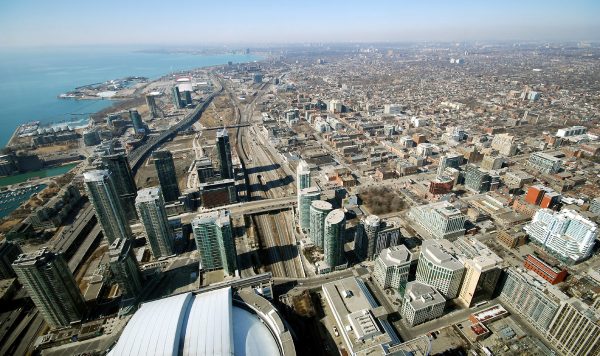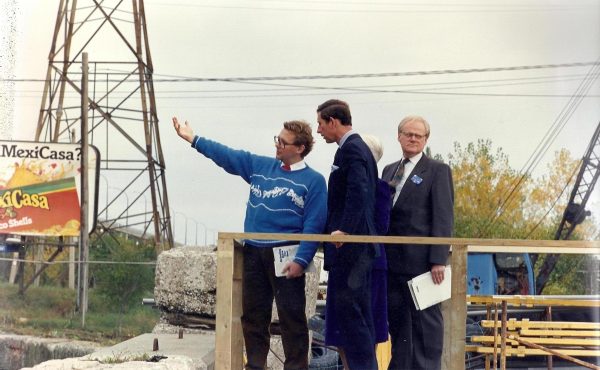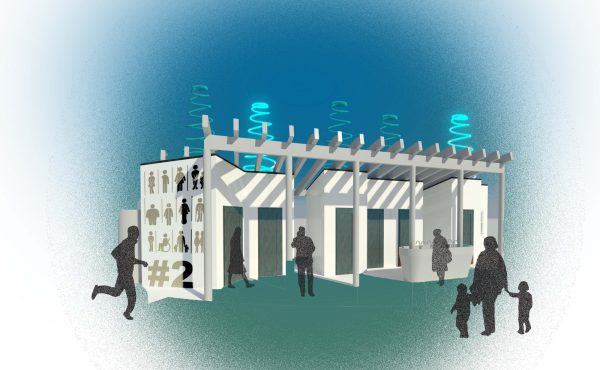
About two years ago, deputy city manager John Livey, Toronto’s top planner, realized the strategy of creating pocket parks and little private plazas around the core wasn’t going to dent the severe shortage of open space downtown. With rapid population growth due to intensification, especially west of Yonge and south of Queen, the city needed to make a big, bold gesture. (The core’s population is projected to reach 500,000 within 25 years.)
The preliminary results of Livey’s lightbulb moment were revealed during yesterday’s Rail Deck Park press conference, although the excited rhetoric about a new central park overshadowed the hard slogging that got us here. According to the area councilor Joe Cressy, Livey’s officials scrutinized a handful of key issues: the ownership of the air rights, the cost, and the technical feasibility.
The air rights, above the 27-foot level, belong to CN Rail, Toronto Terminals Railway and Metrolinx; city officials have determined that they can be acquired. But with developers actively exploring the possibility of privately buying air rights over the corridor, Cressy says council’s key move, when a staff report surfaces in September, will be to approve an official plan amendment designating the entire space above the tracks as open space.
The plan, as my colleague Kieran Delamont explains here, is going to be very expensive, even allowing for the large and unused parkland acquisition reserves that Spacing investigated last year in our “Parks in Crisis” series. Cressy contends that both the province and the feds may put money into the project. But this ask is merely the latest in a long series of big ticket asks, not least of which is the $1 billion flood protection berm that will unlock development on the Portlands. (Let’s not even talk about transit.)
Which brings me to Downsview Park. Those of you who dimly remember the early years of Jean Chretien’s Liberal regime may recall that two of his loyal foot soldiers, Art Eggleton and David Collenette, persuaded the prime minister to donate the decommissioned air force base to the City, alongside similarly high-minded pledges to establish it as Canada’s first national urban park (whatever that means).
Yet after a few years of high-end architects conjuring up fancy visions, it became clear that no one was prepared to put out to actually build the thing, at which point Canada Lands Corporation, the ultimate owner of the land, began cleaving off parcels at the edges for re-development with an eye to using the proceeds to build the park. The idea of encircling a large park with higher density buildings is actually sound planning, but this cross-subsidization strategy was accomplished in an ad hoc and haphazard way. There was more than a little disingenuousness from the various powers that be, and plenty of anti-development yodeling from Maria Augimeri, the local councilor.
From where I sit, the detail to watch as the Rail Deck Park plan moves ahead is whether city council will, in fact, vote to make the entire space public and open, or whether the suburbanites on council push for the Downsview-style self-financing model.
Three other facets of this story seem relevant with the plan now up for discussion:
- The fate of the open space on the southern tier of City Place. Ever since it opened, Canoe Landing has been neglected by the parks department. It is poorly used because of its proximity to a noisy highway, and the lack of intimacy and shade. It seems to me that the City should be re-thinking the existing open space on this precinct completely as it figures out how to build the Rail Deck Park, which will likely be a much more attractive space and thus draw even more pedestrian activity away from Canoe Landing.
- The potential for decking the tracks next to Liberty Village. Concord City Place and Liberty Village are the two worst planned large-scale developments in Toronto – both are isolated, overly dense and populated by transient owners; you buy to generate some equity but you don’t plan to live there. As with City Place, decking next to Liberty Village will help reduce isolation, improve pedestrian linkages, provide much needed open space, and perhaps attract residents looking to stay for a while. In the name of good planning, the City should be looking at decking both locales.
- The use of innovative public or semi-public buildings on this new space. Toronto’s vision of what constitutes a park is notoriously narrow. It seems to me that the OPA should not preclude the City from finding ways to develop community structures on this new deck. After all, winter is long and cold, and the investment in the deck shouldn’t simply be seasonal. What’s more, as the Artscape Wychwood Barns and the Evergreen Brickworks have both proven, parkside buildings with public or non-commercial uses draw crowds, provide animation and offer alternatives to the notion of a park as some amalgam of grass, sports fields, and landscaping.
Ultimately, council needs to think very clearly – always a challenge! – about the long game here. We shouldn’t get distracted by tourist bauble words (“Central Park”!) or fantasies about Millennium Park style doodads. The Rail Deck Park proposal is a smart and far-sighted response to one of the increasingly severe symptoms of Toronto’s addiction to extreme intensification. As such, it holds out a glimmer of hope that those impersonal glass towers brimming with 600 sq.-ft shoebox units may someday evolve into stable communities, with all the broader social, economic and health benefits associated with such urban neighbourhoods.
Toronto has a long tradition of nibbling away at good ideas until they become pointless or nonsensical. Let’s resist the temptation to gnaw at this one.





11 comments
Good points but I have to disagree on the popularity of Canoe Landing. Whenever I pass by I see many people in Canoe Landing and also noting that as it isn’t complete yet, there is not a full perspective to judge. Once the final eastern edge of the park is complete which will include areas for young children to play, we will be better able to judge the usefulness of that park.
Regarding the parks department neglecting the park, this seems to be common across Toronto. I’m most disappointed in Sherbourne Commons. When it was first opened it was excellent, now it feels like it is falling apart due to neglect from the city. I have heard the same about Corktown Commons. I believe this would be a combination of funding and lack of management directive. Local involvement as with Dufferin Grove would go a long way to help each park flourish.
The Parks Department has been cut & cut since 2010. With fewer and fewer seasonal workers and more & more people living south of King using the parks more; the parks across the City are seeing a decline in upkeep.
So instead of paying for what we now have, we cut support and do photo ops for pie (or parks) in the sky
Couple things:
Developers looking into buying up air rights over the proposed park? F*** THAT. Squatters, plain and simple.
Good point about winter use, John. If we don’t plan for that we end up with some kind of windswept hellscape from Christmas to the end of March, with nobody there.
Great article summarizing key points to consider. I also wonder how/if this project will impact the Under Gardiner project. Any thoughts?
The idea that the “City should be re-thinking the existing open space” is a great one. While I don’t use Canoe park often as I am farther west and June Callwood park (Fort York neighbourhood) is my closest park space and it could use a re-think. Someone thought a park with no grass was a good idea – generally the park is good, with a good number of trees, but sitting in the shade is nearly impossible unless you want to sit on loose gravel. This summer benches where added, all on the hard paving and lets not even talk about the how badly the benches don’t go with the rest of the aesthetic of the park.
@Tal, I’d say the Under Gardiner fits very naturally into this plan — the city should figure out how to link one to the other, and then you have more pedestrian connections between King West, Fort York, central waterfront.
@Shelley, June Callwood Park, like Canoe Landing, is an example of high end landscaping/design for its own sake, with very little thought given to context, user experience and other functions. It has no edges, for heavens sake! No wonder people feel exposed there.
We could build the deck over the railway tracks for the Olympics. Then after the Games, convert it to the park. Maybe keep some of the facilities (pools, track, etc.) for the park.
At 8.5 hectares, the proposed Rail Deck Park will be smaller in area than Trinity Bellwoods Park at 14.6 hectares.
Agreed on most of this, but I’m having trouble picturing how you would deck over the rail corridor beside Liberty Village. The Gardiner comes back to ground where the rail corridor runs between Liberty Village and the CNE grounds, so there just isn’t any unobstructed space there. Am I missing something really obvious?
Apart from that, I think it’s worth emphasizing that this giant infrastructure project in the rail lands should include a new satellite GO station to relieve Union Station, and whatever track rearrangements are needed to accommodate it.
Regarding “The fate of the open space on the southern tier of City Place”: Rail Deck Park is necessary to address the severe parkland deficiency in the Downtown and not as a replacement to any existing parks. The scale, location and character of these spaces should inform their programming and how they are utilized. In other words, regardless of their proximity to one another, each may have a local, community or even city-wide function that differs, but in concert all of these spaces serve to ensure the Downtown is livable, family-friendly, appealing and thriving. This is absolutely critical if current growth at these densities is to succeed and be sustained.
Regarding “The potential for decking the tracks next to Liberty Village”: Agreed, and a mind-boggling lost opportunity that could have piggy-backed on the massive investment Metrolinx was already undertaking in sinking the rail corridor and then even introduce a steel frame structure that in essence puts in pace the deck but without the flooring. Ironically, an EA for a pedestrian bridge connection was put on hold while this rail work was being conceived and built. Revisiting this is challenging given that the corridor would need to be sunken further to better level the deck and the existing structure is unlikely to have been designed to support the weight of a park. See the Liberty Village BIA Master Plan for a similar land bridge idea adjacent to Dufferin.
Regarding “The use of innovative public or semi-public buildings on this new space”: I am pretty sure I made certain that the policy as written would not preclude such uses. Most importantly because the deck structure would require a depth of at least a tall one-storey building to be able to clear span some parts of the rail corridor. Hence, many possible public uses (such as schools, community centres, transit stations, maintenance storage and equipment, etc.) may potentially be accommodated within the structure itself. These functions can also be revealed and used to address the frontage along Front Street where the elevation is lower and the deck needs to transition/mitigate to this elevation is as seamless a way as possible. This can all be done while retaining much of the surface above clear of significant structures and thus truly ‘open’ multi-use park space.
@John Duncan, I think the rail corridor beside Liberty Village that is referred to is the rail corridor on the north side of Liberty Village (for Barrie & Georgetown), not the southern Lakeshore West line.
Rail deck park is really exciting. It seems to me that the ultimate vision should be a park all the way from Liberty Village to the Don River, although an eastern park would be trickier since the tracks are so much higher than the surrounding area